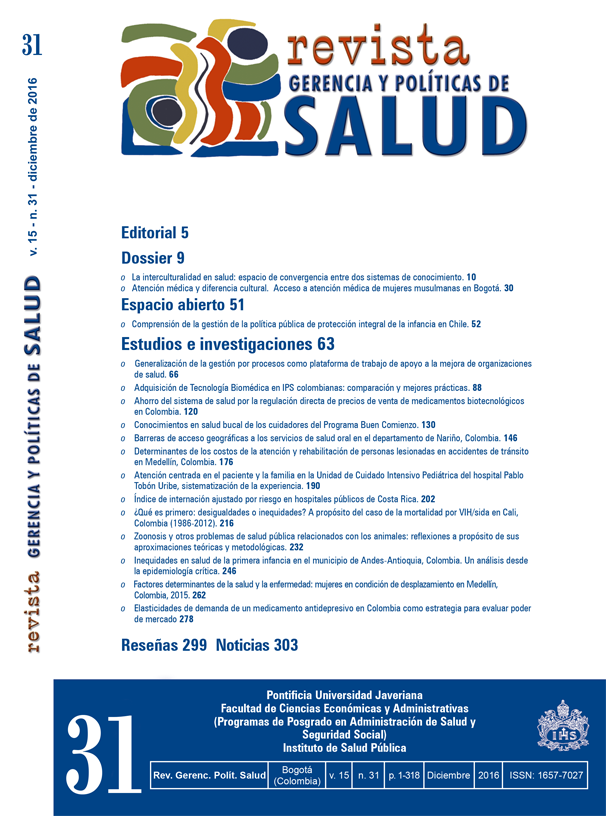Resumen
En este artículo se desarrolló un ejercicio de estimación de la elasticidad precio de la demanda de un medicamento “tipo” utilizado para el tratamiento de la depresión. Este trastorno afecta física y mentalmente a un gran número de personas en el mundo y constituye un problema de salud pública con prevalencia creciente. Se estimaron dos modelos econométricos vectoriales para el periodo anterior a la expedición de la circular 03 del 2013 que regula los precios de los medicamentos en Colombia. Como resultado se obtuvo una elasticidad precio no significativa de 0.35 %, es decir, que los cambios en el precio no generan la respuesta esperada en la demanda, comportamiento que sugiere la existencia de un alto poder de mercado de la empresa que elabora dicho producto “tipo”, lo cual es evidencia de la necesidad de implementar dicha circular.
2. Rodríguez AS, Vásquez VJ, Gómez PK. Regulación en el mercado farmacéutico colombiano. Revista de
Ciencias Sociales. 2010; 16(2):197-209.
3. Circular 03 del 2013. Comisión Nacional de Precios de Medicamentos y Dispositivos Médicos, Colombia.
4. Consejo Nacional de Política Económica y Social, Departamento Nacional de Planeación, Colombia. Documento Conpes Social. Política farmacéutica nacional. Proyecto para discusión. Bogotá: Departamento
Nacional de Planeación; 2012.
5. Machado-Alba JE, Morales Plaza CD, Solarte Gómez MJ. Patrones de prescripción de antidepresivos en pacientes afiliados al Sistema General de Seguridad Social en Salud de Colombia. Rev Panam Salud Pública. 2011; 30(5):461-8.
6. Center for Global Development. A Risky business. Saving money and improving global health through
better demand forecasts. Washington D. C.: Library of Congress Cataloging-in-Publication Data; 2007.
7. Managing Science for Health. MDS-3: Managing access to medicines and health technologies. Arlington,
VA: Management Science for Health; 2012.
8. Ghousi R, Mehrani S, Momeni M, Anjomshoaa S. Application of data mining techniques in drug consumption forecasting help pharmaceutical industry production planning. Proceedings of the 2012 International Conference on Industrial Engineering and Operations Management; 2012 Jul 3-6; Estambul, Turquía. Irán: Iran University of Science and Technology, Narmak; 2012.
9. Ching AT. Consumer learning and heterogeneity: dynamics of demand for prescription drugs after patent expiration. Int J Ind Organ. 2010; 26(6): 619-638.
10. Kim W, Won JH, Park S, Kang J. Demand forecasting models for medicines through Wireless sensor networks data and topic trend analysis. International Journal of Distributed Sensor Networks. 2015; 36.
11. Fisher S, Cockburn I, Griliches Z, Hausman J. Characteristics of demand for pharmaceutical products: An examination of four cephalosporins. Rand J Econ.1997; 28(3):426-46.
12. Hurtado JL, Melo LF. Una metodología multivariada de desagregación temporal. Borradores de Economía del Banco de la Republica. 2010; (586):1-37.
13. Quilis EM. A matlab library of temporal disagregation methods: Summary. Madrid: Instituto Nacional de Estadística; 2004.
14. Flores de Frutos R, Pereira AM. Public capital and aggregate growth in the United States: Is public capital productive? Documentos de Trabajo del Instituto Complutense de Análisis Económico (ICAE). 1993; (13):1-33.
15. Roca O, Pereira AM. Impacto de la inversión en infraestructura sobre el producto, la ocupación y la inversión privada en España. Revista Española de Economía. 1998; 15(3):403-32.
16. Pesaran H, Shin Y. Generalized impulse response analysis in linear multivariate models. Economics Letters. 1998; 58(1):17-29.
17. Torres S, Gutiérrez JP. Mercado farmacéutico en México: tamaño, valor y concentración. Rev Panam Salud Pública. 2009; 26(1):46-50.
18. Callejón MR, Ortún RV. Los medicamentos en España: Mercado único y utilidad social. Revista Economía Industrial del Ministerio de Industria, Energía y Turismo.1990 Jul.-Agos.; 191-206.
La revista Gerencia y Políticas de Salud se encuentra registrada bajo la licencia Creative Commons Reconocimiento 4.0 Internacional. Por lo tanto, esta obra se puede reproducir, distribuir y comunicar públicamente en formato digital, siempre que se reconozca el nombre de los autores y a la Pontificia Universidad Javeriana. Se permite citar, adaptar, transformar, autoarchivar, republicar y crear a partir del material, para cualquier finalidad (incluso comercial), siempre que se reconozca adecuadamente la autoría, se proporcione un enlace a la obra original y se indique si se han realizado cambios. La Pontificia Universidad Javeriana no retiene los derechos sobre las obras publicadas y los contenidos son responsabilidad exclusiva de los autores, quienes conservan sus derechos morales, intelectuales, de privacidad y publicidad.
El aval sobre la intervención de la obra (revisión, corrección de estilo, traducción, diagramación) y su posterior divulgación se otorga mediante una licencia de uso y no a través de una cesión de derechos, lo que representa que la revista y la Pontificia Universidad Javeriana se eximen de cualquier responsabilidad que se pueda derivar de una mala práctica ética por parte de los autores. En consecuencia de la protección brindada por la licencia de uso, la revista no se encuentra en la obligación de publicar retractaciones o modificar la información ya publicada, a no ser que la errata surja del proceso de gestión editorial. La publicación de contenidos en esta revista no representa regalías para los contribuyentes.


